________________
220
A COMPREHENSIVE HISTORY OF JAINISM
Lādha (Koțivarsa), Kekaya (Svetikā). In the same sūtra a number of so-called non-Aryan tribes like Saka, Yavana, Cina, Hūņa, Romaka, Andhra, Pārasa, etc. are mentioned. A large number of professional classes are also referred to. The various scripts, which have already been noticed, are also mentioned in this sūtra.
The fifth and sixth Upānga texts, Suryaprajñapt7222 and Candraprajñapti, throw a flood of light on ancient Indian knowledge of astronomy. The present Candraprajñapti is not in any way different from the Suryaprajñapti. The seventh Upānga text, the Jambudvīpaprajñapti,223 throws some light not only on astronomy but also geography. It has altogether 176 sūtras. The most significant is the reference to Alasamda, i.e., Alexandria, in sūtra no. 52. The same sutra refers to Arabaka, Romaka, Yavanadvipa, Simhala, Barbara, etc. The god Naigamesī (Kārttikeya) is mentioned in sūtra no. 115.
The last five Upānga texts are actually five vargas (sections) of one Upānga work, the Nirayavalikā.224 As I have already said, this particular work throws some welcome light on contemporary history. I have already referred to the fight between Cetaka and Ajātaśatru described in this Upānga text. It has a vytt7225 by Candrasūri, who lived in the early twelfth century AD. We are told that one of the sons of Sreņika, called Kāla (his mother was one Kālī,226 described as cullamāuyā, i.e., stepmother of Kūņika) was killed by Cetaka in the Rathamusala war. According to the author227 of the text, Kāla went to Naraka because he was killed in a war. Unlike the author of the Gītā, the Jaina writer of the Nirayavalikā never believes that the death in the battlefield enables the hero to attain svarga. According to this text Srenika-Bimbisāra committed suicide, 228 a statement con tradicted by the evidence of the Buddhist canon. We further learn that afterwards the remorse-stricken Künika-Ajātaśatru transferred his capital to Campā.229 However, the description of the war230 appears to be exaggerated. Ten other brothers of Ajātaśatru are also named in this text, including Vehalla, son of Cellanä.231 Abhaya is described as the eldest son of Sreņika by his wife Nandā, but according to the Buddhists his mother was Padmavati, a prostitute of Ujjayini.232 The Buddhist texts, however, confirm the Jaina account that this prince was originally a devotee of Mahāvīra.233 We are told by the Jaina author of this Upānga text that with the help of this prince Śreņika fulfilled the dohada—longing234 stage-of Cellaņā.
The second varga of this text called Kalpāvatamśikā does not contain much information, but in the third called Puspikā, there is a




